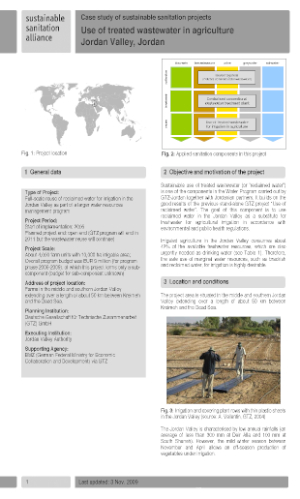Use of treated wastewater in agriculture Jordan Valley, Jordan - Case study of sustainable sanitation projects
Vallentin, A., Schlick, J., Klingel, F., Bracken, P., Werner, C. (2009)

Published in: 2009
Publisher:
Sustainable Sanitation Alliance (SuSanA)
Author:
Vallentin, A., Schlick, J., Klingel, F., Bracken, P., Werner, C.
Uploaded by:
SuSanA secretariat
Partner profile:
common upload
13715 Views
289 Downloads
Location of library entry
Content - Summary
This case study is about a full-scale project for reuse of reclaimed water for irrigation in the Jordan Valley as part of a larger water resources management program carried out by GIZ on behalf of the BMZ (German Federal Ministry for Economic Collaboration and Development). About 4,000 farm units with 10,000 ha irrigable area shall be irrigated with the reclaimed water. The whole budget of the water program in the first phase (2006-2009) was EUR 9 million, and it is EUR 4.5 million for the second phase (2009-2011).
Irrigated agriculture in the Jordan Valley consumes about 42% of the available freshwater resources, which are also urgently needed as drinking water. Therefore, the safe use of marginal water resources, such as brackish and reclaimed water, for irrigation is highly desirable.
Project staff members have tested the agronomic guidelines through a series of demo sites with pilot farmers. To ensure the widespread application of these guidelines by farmers, simplified fertigation (irrigation and fertilisation) sheets were developed and disseminated to farmers in 2007 and 2008 through intensive training sessions with local extension agencies in the Jordan Valley. Currently, the Ministry of Environment supervises the enforcement of the environmental law that prohibits illegal dumping of industrial waste before it receives treatment.
Treated effluent, which is reused for irrigation, is diluted with surface and precipitation water by the passage through small streams etc. The water flows by gravity from the WWTP (waste water treatment plant) via KTR (King Talal Reservoir) to the agricultural fields. Pumping is not required as KTR is located 600 m above sea level and the valley 200 m below sea level. The preferred irrigation method is drip irrigation in combination with very thin plastic sheets (in Jordan called “mulch”) which cover the plant rows. The typical crops are all kind of vegetables in open field and greenhouse cultivations.
Main impacts of this project are the reduction of artificial mineral fertiliser use in the middle and southern part of the Jordan Valley, lowering the soil salinisation pace and the saving costs. It is estimated that farmers would save up to 60% of their fertilisation cost, which is equivalent to EUR 564 per ha and can be translated into income improvements of 30%.
Bibliographic information
Vallentin, A., Schlick, J., Klingel, F., Bracken, P., Werner, C. (2009). Use of treated wastewater in agriculture Jordan Valley, Jordan - Case study of sustainable sanitation projects. Sustainable Sanitation Alliance (SuSanA)
Filter tags
Case studies in SuSanA template English Greywater or wastewater Middle East & North Africa Peri-urban















